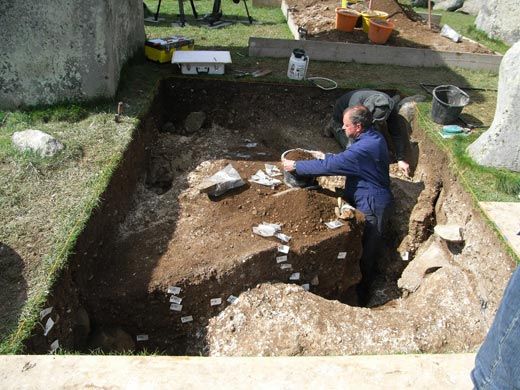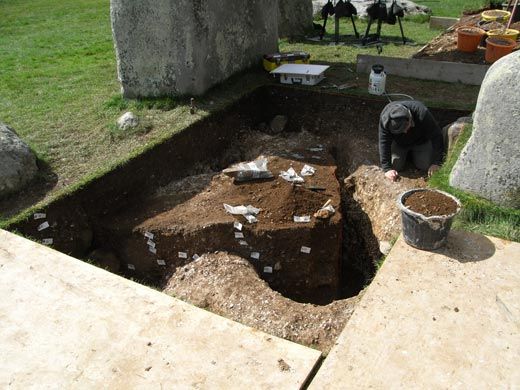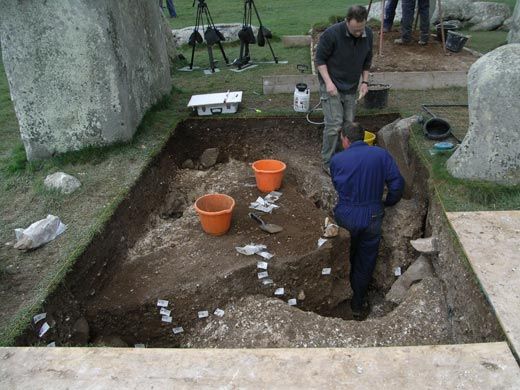Dispatch from Stonehenge, Day 9
April 8: The Clock is Ticking
/https://tf-cmsv2-smithsonianmag-media.s3.amazonaws.com/filer/dis3-stonehenge-631.jpg)
After a further week of digging, shoveling and sifting, the archaeologists at Stonehenge continue to make discoveries within the inner circle of the monument. Even the old backsoil, filled in after earlier excavations, is offering up new finds. A student named Chris Watkins discovered a piece of finely patterned pottery, an inch or two across, from the "Bell-Beaker culture" that existed throughout western Europe around 3,000-2,000 B.C. (Scottish archaeologist John Abercromby came up with the name for this prehistoric society in 1904, inspired by the distinctive shape of their drinking vessels.) Part of a broach, along with a Roman coin dating from the 4th century, have also been recovered.
But the key focus of the excavation is still the bluestones. Stonehenge was built in stages over the millennia. Initially, the site consisted of little more than a large circular ditch, surrounded by a bank of earth. This circular "henge" became a stone henge with the placement of a series of bluestones, which were originally arranged in two concentric circles. The most startling change at the site after a week is a deep V-shaped trench dug across the middle of the excavation plot. This has exposed the sockets that originally held the bluestones; the sockets were carved into the chalk bed about 1.5 feet under the current ground level. Material retrieved from these sockets, which were packed with stone fragments to stabilize the bluestones, could yield crucial evidence for dating the arrival of the bluestones at Salisbury Plains.
The team is also now excavating virgin soil—not touched by previous digs—which has been found to contain bluestone and sarsen fragments. Archaeologist Tim Darvill suspects that the bluestone fragments (which are more numerous) are the result of the bluestones' systematic destruction. Pilgrims wanting to take bluestone away with them after visiting the sacred site knocked off chunks 4 or 5 inches square—a practice that likely continued up until relatively recent times. As archaeologist Geoff Wainwright points out, until the 19th century you could hire hammers from nearby Salisbury so that you could take your own little bit of Stonehenge home with you.
Despite their progress, the archaeologists are feeling the pressure. Not only is the "heavy hand of history," as Wainwright puts it, looming over their dig—and perhaps, more crucially, over the interpretations of what they find—but time is growing short. There is still much to excavate before the dig concludes on April 11. The team believes they're making good progress, yet as is so often the case at the Wimbledon tennis championships, weather could halt play, or at least slow it down. Recent snow, sleet and rain have not made life easy for those digging and scraping in the trench, or for the nearby group trying to sort, clean, dry and classify the unearthed material.
To answer the most important question—Precisely when did the bluestones arrive at Stonehenge?—the archaeologists need to get their hands on some good samples of carbon material (such as charcoal) in the vicinity of the bluestones that can be carbon-dated. As such, it is critical to accurately record the layer and type of soil where the carbon remains are found. This can't be a rush job. Darvill and Wainwright, however, remain confident they will get the material they need.
Stonehenge has stood for some 5,000 years. But for the archaeologists seeking to unravel its secrets, the clock is ticking.
Dan Jones is a freelance science writer who has contributed articles to New Scientist.


